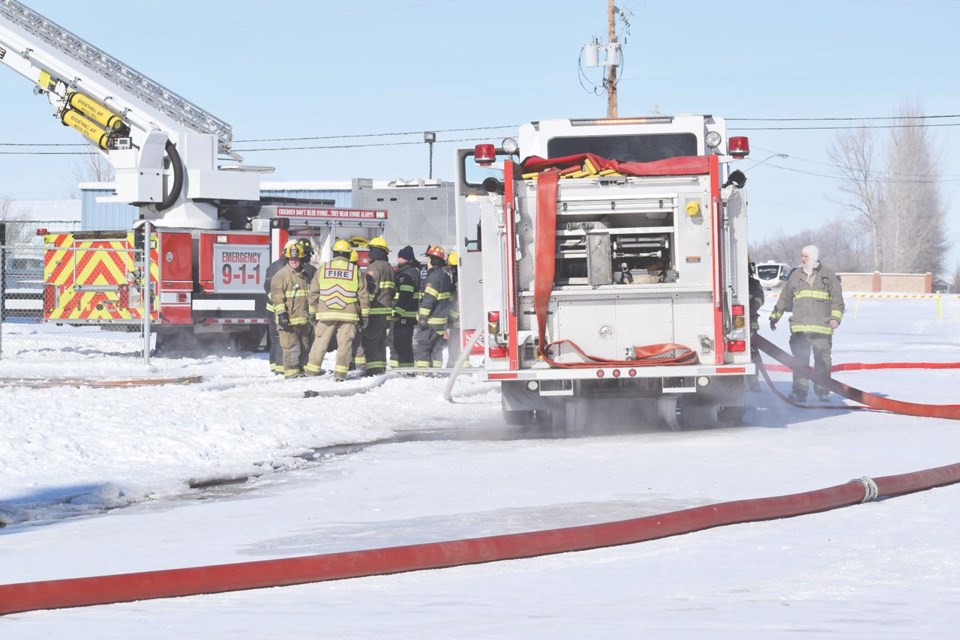Members of the Estevan Fire Rescue Service spent the bulk of the day on Friday contending with a fire at the former Sanjel building in north Estevan.
The fire department was called to the fire at around 8 a.m. While it didn’t take long to contain the fire, the firefighters didn’t finish at the scene until late Friday afternoon, due to some of the challenges posed by the fire.
They also had to contend with the very frigid conditions that day, particularly in the morning.
Upon arriving at the scene, firefighters established suppression efforts to contain the fire to the area of origin, which appeared to be an old mechanical maintenance room.
“The initial takedown occurred quite quickly, and we were able to contain it, however, there was structural compromise that occurred on the second floor, creating a little bit of a hazard for firefighters to get to and extinguish certain spots,” said Fire Chief Dale Feser.
There wasn’t a risk to surrounding buildings from the fire, since the former Sanjel building is a large structure on its own on the property line. There also wasn’t a risk to the public, and Feser appreciates that the public respected the barricades set up on Edward Street and Victoria Avenue near the fire location.
During the afternoon, the ladder truck had to be used, because the fire extended into the roofline and the eaves of the building. With structural compromise already occurring, and a metal tin roof, the fire department didn’t want to send firefighters in to negotiate a very slippery slope and use more water.
“We did use the aerial platform truck so that way the firefighters can safely work from that platform, because that’s what it’s designed to do.”
Piercing nozzles were used to penetrate the tin, and get some suppression water on it to stop the forward progress of the fire.
“Once the fire is brought under control, then we start stripping some of the metal so that way we can see if there’s any extensions or hot spots that are still occurring.”
About 20 firefighters were called to the scene, and most were there throughout the day. Seven apparatus units, including the ladder truck, a fire engine, a tender truck, three command vehicles and a utility truck, were used.
The building had been vacant for some time, as Sanjel moved to a new facility west of city limits a few years ago. Feser pointed out there wasn’t any office furniture still in the building.
“The fire did itself start in the mechanical maintenance room area that was on the shop side of the occupancy, and extended laterally into the office portion of the commercial occupancy,” said Feser.
An official cause of the fire hasn’t been determined. The fire department believes it was something in the mechanical room.
No injuries occurred in the fire, and none of the firefighters suffered smoke inhalation or frostbite, despite the amount of time they spent at the scene.
The extreme cold did pose some challenges. An extreme cold warning was in place when the fire broke out, and while that warning was lifted before the end of the day, the frigid temperatures persisted.
One of the fire hydrants that the fire department was trying to use when they arrived was actually frozen. A quick radio call was made to the City of Estevan’s public works division, and they steamed up the hydrant to establish water supply.
“As soon as we run into issues like that, we follow up with a tender unit so that way we have water regardless,” said Feser. “One of our trucks just delivered water to the scene until we can re-establish water supply from the hydrant system.”
The city’s safety co-ordinator Helen Fornwald assisted the fire department as well, and arranged for a school bus to be brought to the scene so that the firefighters could remain warm.
“We try to cycle everybody in and out there, so that way everybody’s getting a chance to warm up and what not, so of course when you’re inside doing attack and suppression operations where the fire is, you’re staying nice and warm, but after a couple of bottles on an SCBA, we typically pull that person out regardless, and send them into a little bit of a rest area, and that way they can rest and recover and rehydrate,” said Feser.
Food and coffee were also brought to the scene.
In addition to the risk of a hydrant freezing up, Feser said the fire department also has to make sure hose lines don’t become frozen. They were thawed out quickly, and put back into service.
And when the property is vacant, the snow hasn’t been removed, so their apparatus had to be set up on the street to ensure they don’t get stuck in the snow.
The size of the building also posed some challenges, because it took additional time to clear the scene.
“We knew that there definitely wasn’t anybody in the structure, but we still can’t take that for granted, and the crews still do primary searches to search for anybody that might be trapped inside before we really get into any fire suppression operations.”
A decision has not been made on what will happen to the building. Feser said it’s now in the hands of the insurance company. The structure is still standing, and while there is damage, Feser said it should be repairable.



